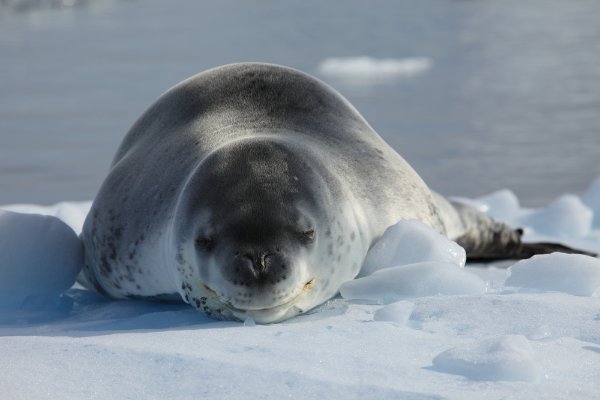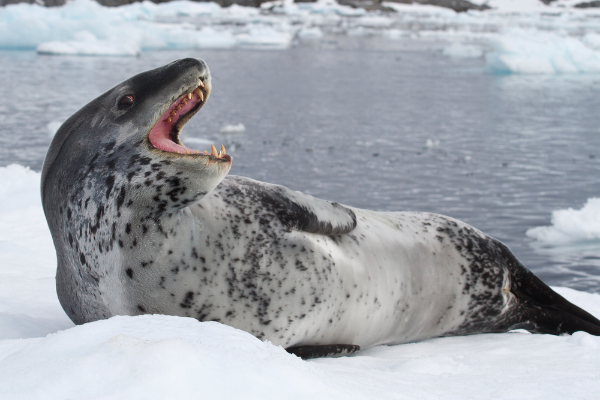A leopard seal is not your average seal. With its prominent black spots and reddish coat, it easily stands out from the pack. Despite their large size – they can weigh up to 400 kg – leopard seals are often difficult to spot, both in the water and on land. Nicknamed ‘sea wolves’, these creatures are one of the most ferocious predators in the Antarctic waters. So what do you need to know about leopard seals? Keep reading to find out!

Leopard Seal Description
Leopard seals are large, predatory marine mammals that are found in the Southern Ocean. They get their name from their Leopard-like spots, which are actually dark blotches on a light-colored background. Leopard seals grow to be about 11 feet long and can weigh up to 880 pounds. They are one of the largest seals in the world. Leopard seals are very good swimmers and can dive to depths of more than 1,000 feet. They prey on fish, squid, penguins, and other seals. Leopard seals have sharp teeth and powerful jaws that they use to catch their prey. They also have long, strong claws that they use for killing and for grasping ice. Leopard seals are solitary animals that live alone or in small groups. Females give birth to one pup every year on sea ice. The pups weigh about 50 pounds at birth and are about 3 feet long. They grow quickly and are weaned after about 4 months. Leopard seals can live for up to 30 years in the wild.
Leopard Seal Habitat
Leopard seals are found in the Southern Ocean, surrounding Antarctica. They prefer to live in areas of open water, where they can more easily find their preferred food source: fish, squid, krill, and penguins. Leopard seals are also known to eat seals, and will sometimes hunt in pairs in order to take down larger prey. Leopard seals are excellent swimmers, and have been known to reach speeds of up to 30 mph when chasing their prey. They are also expert divers, and can remain underwater for up to 30 minutes at a time. Leopard seals typically live alone, but can often be found sunbathing or socializing on ice floes.
Leopard Seal Diet
Leopard seals are large, predatory marine mammals that are found in the southern hemisphere. Their diet primarily consists of fish, penguins, and other seal species. Leopard seals have been known to eat up to 100 penguins in a single day. They are also capable of taking down large adult elephant seals, which can weigh over three times as much as the Leopard seal. In addition to their impressive hunting skills, Leopard seals are also excellent swimmers and can dive to depths of over 1,000 meters. These abilities make them one of the top predators in the marine environment.
Leopard Seal Size
Leopard Seals are the second largest seal in the Antarctic after the Elephant Seal. They can grow to be up to 11 feet long and weigh up to 770 pounds. Leopard Seals get their name from their spots, which are similar to those of a leopard. Leopard Seals are found in the Antarctic and sub-Antarctic regions. They prefer areas with ice, but can also be found in open water. Leopard Seals are solitary animals, but can be found in large groups during the breeding season. Leopard Seals primarily eat fish, but will also eat penguins, squid, and seals. Leopard Seals are predators, and have no natural predators themselves. Humans are not a threat to Leopard Seals, but they have been known to attack and kill humans if they feel threatened.
Leopard Seal Lifespan
Leopard seals can live up to 30 years in the wild. Leopard seals are carnivorous predators and eat a variety of prey including fish, squid, krill, penguins, and other seals. Leopard seals are solitary animals except for during the breeding season. They give birth to a single pup on an ice floe which they nurse for about a week before leaving it alone. The pup is capable of swimming and hunting on its own within a few weeks. Leopard seals are protected under the Marine Mammal Protection Act of 1972. Although they are not considered endangered, their numbers are believed to be declining due to climate change and human activity such as hunting and fishing.

Leopard Seal Behavior
Leopard seals are large, predatory marine mammals that are found in the southern regions of the world. They are known for their hunting abilities and their aggressive nature. Leopard seals typically live alone or in small groups, and they are often seen preying on penguins, other seals, and fish. During the breeding season, Leopard seals come together to mate. After a gestation period of about 10 months, seal pups are born. Leopard seal pups are black or dark gray in color, and they have white spots on their backs and sides. Leopard seal pups spend their first few months of life close to their mothers. After weaning, they begin to hunt on their own. Leopard seals can live up to 30 years in the wild.
Leopard Seal Speed
Leopard seals are one of the fastest swimming animals in the world, capable of reaching speeds of up to 25 miles per hour. They are also able to maintain this speed for long periods of time, making them a formidable opponent in the water. Leopard seals are predators, and their speed allows them to chase down their prey with ease. They are also very agile, able to make sharp turns and sudden movements in order to catch their prey off guard. In addition to being fast swimmers, leopard seals are also excellent divers, able to reach depths of up to 1,000 feet. This allows them to hunt for food in a wide variety of environments, including the open ocean and the deep sea. Leopard seals are a fascinating species, and their unique abilities make them one of the top predators in the animal kingdom.
Leopard Seal Hunting
Leopard seals are one of the most feared predators in the Antarctic. They are large, ferocious, and have a reputation for attacking humans. Despite their fearsome reputation, leopard seals are actually quite shy and will only attack if they feel threatened. They are also an important part of the ecosystem, helping to keep penguin and seal populations in check. For these reasons, leopard seal hunting is strictly regulated by the Antarctic Treaty. Hunting is only allowed for scientific or research purposes, and all kills must be reported to the treaty organization. In addition, hunters are required to take measures to avoid hurting Seal populations. As a result, Leopard Seal hunting is closely monitored and controlled in order to protect this important species.
Conclusion
The leopard seal is an amazing creature that has many unique and interesting adaptations. They are well-suited for their environment and have evolved to be one of the top predators in the Antarctic waters. Their hunting techniques are fascinating and their ability to survive in such a harsh climate is admirable. We hope you’ve enjoyed learning about these amazing animals as much as we have!
Frequently Asked Question

